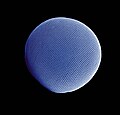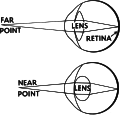Vertebrates (/ˈvɜːrtəbrɪts, -ˌbreɪts/) are deuterostomal animals with bony or cartilaginous axial endoskeleton — known as the vertebral column, spine...
78 KB (7,108 words) - 04:02, 7 July 2024
Vertebrate zoology is the biological discipline that consists of the study of Vertebrate animals, i.e., animals with a backbone, such as fish, amphibians...
2 KB (193 words) - 22:07, 27 December 2023
A Laboratory Manual for Comparative Vertebrate Anatomy is a textbook written by Libbie Hyman in 1922 and released as the first edition from the University...
2 KB (118 words) - 10:43, 14 July 2024
Gnathostomata (redirect from Jawed vertebrate)
'mouth') are the jawed vertebrates. Gnathostome diversity comprises roughly 60,000 species, which accounts for 99% of all living vertebrates, including humans...
29 KB (1,997 words) - 02:58, 9 June 2024
Brain (redirect from Vertebrate brain)
brain is an organ that serves as the center of the nervous system in all vertebrate and most invertebrate animals. It consists of nervous tissue and is typically...
131 KB (15,592 words) - 16:12, 29 May 2024
Amniote (redirect from Higher vertebrate)
vertebrate animals belonging to the clade Amniota, a large group that comprises the vast majority of living terrestrial and semiaquatic vertebrates....
44 KB (3,415 words) - 01:55, 11 July 2024
Nervous system (redirect from Nervous system (vertebrate))
first arose in wormlike organisms about 550 to 600 million years ago. In vertebrates, it consists of two main parts, the central nervous system (CNS) and...
72 KB (9,262 words) - 15:22, 6 June 2024
Marine vertebrates are vertebrates that live in marine environments. These are the marine fish and the marine tetrapods (primarily seabirds, marine reptiles...
30 KB (3,123 words) - 10:24, 2 June 2024
Invertebrate (redirect from Non-vertebrate)
including all animals excluding the chordate subphylum Vertebrata, i.e. vertebrates. Well-known phyla of invertebrates include arthropods, mollusks, annelids...
44 KB (4,871 words) - 20:34, 2 July 2024
Many vertebrates are limbless, limb-reduced, or apodous, with a body plan consisting of a head and vertebral column, but no adjoining limbs such as legs...
8 KB (905 words) - 05:11, 22 June 2024
Agnatha (redirect from Jawless vertebrates)
ostracoderms) species. Among recent animals, cyclostomes are sister to all vertebrates with jaws, known as gnathostomes. Molecular data, both from rRNA and...
43 KB (2,778 words) - 10:01, 7 July 2024
Anamniotes (redirect from Lower vertebrate)
the 20th century, may refer to anamniotes as "lower vertebrates" and amniotes as "higher vertebrates", based on the antiquated idea of the evolutionary...
6 KB (606 words) - 02:26, 10 April 2024
Vertebrate Palaeontology is a basic textbook on vertebrate paleontology by Michael J. Benton, published by Blackwell's. It has so far appeared in four...
4 KB (372 words) - 09:41, 26 March 2024
Eye (redirect from Eye (vertebrate))
evolved in 96% of animal species in six of the ~35 main phyla. In most vertebrates and some molluscs, the eye allows light to enter and project onto a light-sensitive...
60 KB (7,519 words) - 16:26, 5 June 2024
mitochondrial membrane protease ATP23, which are exclusively shared by all vertebrates, tunicates and cephalochordates. These CSIs provide molecular means to...
53 KB (4,904 words) - 00:11, 3 July 2024
Fish (category Obsolete vertebrate taxa)
A fish (pl.: fish or fishes) is an aquatic, anamniotic, gill-bearing vertebrate animal with swimming fins and a hard skull, but lacking limbs with digits...
102 KB (10,185 words) - 16:46, 9 July 2024
Accommodation is the process by which the vertebrate eye changes optical power to maintain a clear image or focus on an object as its distance varies....
38 KB (4,667 words) - 18:46, 9 July 2024
This is an incomplete list that briefly describes vertebrates that were extant during the Maastrichtian, a stage of the Late Cretaceous Period which extended...
114 KB (162 words) - 10:38, 25 April 2024
The Institute of Vertebrate Paleontology and Paleoanthropology (IVPP; Chinese: 中国科学院古脊椎动物与古人类研究所) of China is a research institution and collections repository...
2 KB (166 words) - 22:05, 16 February 2023
Evolution of the Vertebrates, subtitled "A History of the Backboned Animals Through Time" is a basic paleontology textbook by Edwin H. Colbert, published...
4 KB (425 words) - 19:38, 5 October 2021
or crystalline lens, is a transparent biconvex structure in most land vertebrate eyes. Relatively long, thin fiber cells make up the majority of the lens...
52 KB (6,471 words) - 13:51, 26 June 2024
The domestication of vertebrates is the mutual relationship between vertebrate animals including birds and mammals, and the humans who have influence...
70 KB (7,806 words) - 18:18, 22 February 2024
Endocrine system (redirect from Vertebrate endocrine system)
the circulatory system and that target and regulate distant organs. In vertebrates, the hypothalamus is the neural control center for all endocrine systems...
39 KB (4,602 words) - 12:35, 13 July 2024
Amphibians are ectothermic, anamniotic, four-limbed vertebrate animals that constitute the class Amphibia. In its broadest sense, it is a paraphyletic...
161 KB (17,922 words) - 14:21, 2 July 2024
The Museum of Vertebrate Zoology is a natural history museum at the University of California, Berkeley. The museum was founded by philanthropist Annie...
3 KB (172 words) - 16:50, 30 September 2022
The kidneys are a pair of organs of the excretory system in vertebrates, which maintain the balance of water and electrolytes in the body (osmoregulation)...
48 KB (5,376 words) - 16:39, 22 May 2024
Vertebrate visual opsins are a subclass of ciliary opsins and mediate vision in vertebrates. They include the opsins in human rod and cone cells. They...
10 KB (1,049 words) - 21:31, 14 July 2024
EAVP (redirect from European Association of Vertebrate Palaeontologists)
of Vertebrate Palaeontologists (EAVP) is a society for the advancement of vertebrate palaeontology in Europe. The European Association of Vertebrate Palaeontologists...
4 KB (547 words) - 19:15, 31 October 2020
below. Anatomical axes in a human, similar for other orthograde bipedal vertebrates Anatomical axes and directions in a fish Spheroid or near-spheroid organs...
44 KB (5,129 words) - 21:30, 22 May 2024
The Journal of Vertebrate Paleontology is a bimonthly peer-reviewed scientific journal that was established in 1980 by Jiri Zidek (University of Oklahoma)...
2 KB (96 words) - 14:11, 29 April 2023



















